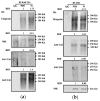K48-Linked Ubiquitination Contributes to Nicotine-Augmented Bone Marrow-Derived Dendritic-Cell-Mediated Adaptive Immunity
- PMID: 33808531
- PMCID: PMC8003133
- DOI: 10.3390/vaccines9030278
K48-Linked Ubiquitination Contributes to Nicotine-Augmented Bone Marrow-Derived Dendritic-Cell-Mediated Adaptive Immunity
Abstract
K48-linked ubiquitination determining antigen degradation and the endosomal recruitments of p97 and Sec61 plays vital roles in dendritic cell (DC) cross-presentation. Our previous studies revealed that nicotine treatment increases bone marrow-derived dendritic cell (BM-DC) cross-presentation and promotes BM-DC-based cytotoxic T lymphocyte (CTL) priming. But the effect of nicotine on K48-linked ubiquitination and the mechanism of nicotine-increased BM-DC cross-presentation are still uncertain. In this study, we first demonstrated that ex vivo nicotine administration obviously increased K48-linked ubiquitination in BM-DC. Then, we found that K48-linked ubiquitination was essential for nicotine-augmented cross-presentation, BM-DC-based CTL priming, and thereby the superior cytolytic capacity of DC-activated CTL. Importantly, K48-linked ubiquitination was verified to be necessary for nicotine-augmented endosomal recruitments of p97 and Sec61. Importantly, mannose receptor (MR), which is an important antigenic receptor for cross-presentation, was exactly catalyzed with K48-linked ubiquitination by the treatment with nicotine. Thus, these data suggested that K48-linked ubiquitination contributes to the superior adaptive immunity of nicotine-administrated BM-DC. Regulating K48-linked ubiquitination might have therapeutic potential for DC-mediated immune therapy.
Keywords: K48 ubiquitination; adaptive immunity; bone marrow precursor cells; dendritic cells; nicotine; ubiquitin.
Conflict of interest statement
The authors declare no conflict of interest.
Figures









Similar articles
-
K48- and K27-mutant ubiquitin regulates adaptive immune response by affecting cross-presentation in bone marrow precursor cells.J Leukoc Biol. 2022 Jul;112(1):157-172. doi: 10.1002/JLB.4MA0222-419RR. Epub 2022 Mar 30. J Leukoc Biol. 2022. PMID: 35352390
-
Ex vivo IL-15 replenishment augments bone marrow precursor cell-mediated adaptive immunity via PI3K-Akt pathway.J Leukoc Biol. 2020 Jul;108(1):177-188. doi: 10.1002/JLB.1MA0220-337RR. Epub 2020 Apr 15. J Leukoc Biol. 2020. PMID: 32293057
-
PYR-41 and Thalidomide Impair Dendritic Cell Cross-Presentation by Inhibiting Myddosome Formation and Attenuating the Endosomal Recruitments of p97 and Sec61 via NF-κB Inactivation.J Immunol Res. 2018 Jul 5;2018:5070573. doi: 10.1155/2018/5070573. eCollection 2018. J Immunol Res. 2018. PMID: 30069488 Free PMC article.
-
Targeting dendritic cells for priming cellular immune responses.J Mol Recognit. 2003 Sep-Oct;16(5):299-317. doi: 10.1002/jmr.650. J Mol Recognit. 2003. PMID: 14523943 Review.
-
Regulation of antigen transport into the cytosol for cross-presentation by ubiquitination of the mannose receptor.Mol Immunol. 2013 Sep;55(2):146-8. doi: 10.1016/j.molimm.2012.10.010. Epub 2012 Nov 3. Mol Immunol. 2013. PMID: 23127488 Review.
References
Grants and funding
LinkOut - more resources
Full Text Sources
Other Literature Sources

